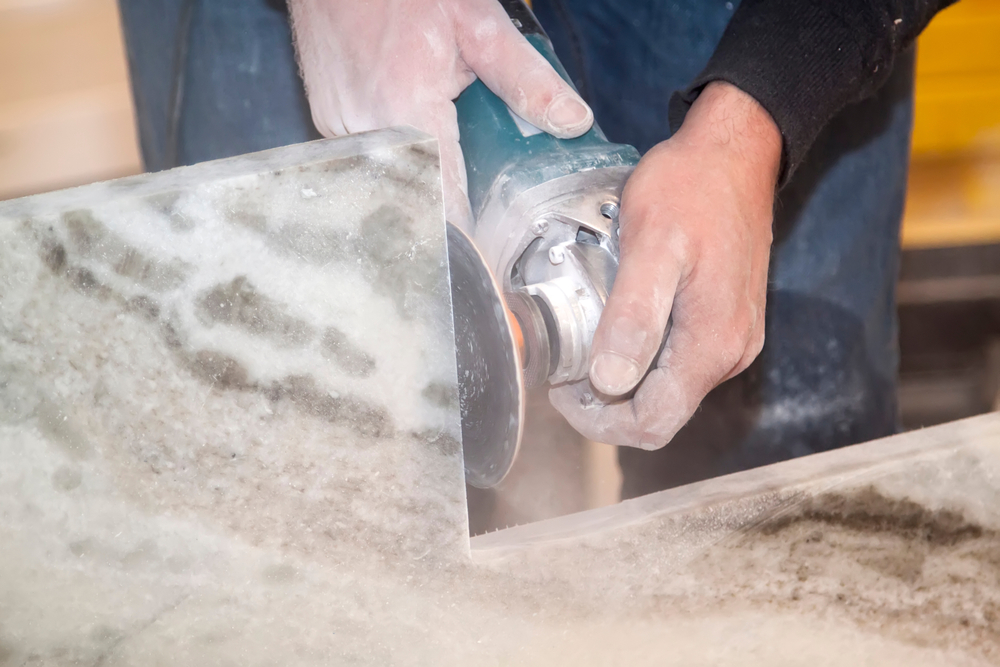Cutting marble countertops can seem like a complicated project. This is especially the case if you have no prior experience working with marble. However, through this guide, you will learn that cutting marble countertops is a pretty straightforward task you can accomplish with not too many tools and careful planning. Through this step-by-step explanation, you will learn how to cut marble countertops and more.
Marble is known for its sophisticated appearance and timeless beauty. It is one of the most popular choices among countertop material options because it adds a luxurious aura to any space it is installed in.
Cutting this beautiful stone requires a lot of pre-planning and careful measurements to ensure the slab fits perfectly into the countertop space. The correct fit will complete the space. On the other hand, ill-fitting countertops will be less durable and won’t be able to retain their elegance in the long run.
Understanding Marble
Marble has been associated with the appearance of opulence and sophistication for a long time. It brings an organic and natural texture to the space. Moreover, its natural veining patterns embellish the countertops with the signature look of marble, creating visual interest in the space while still being subtle.
Before learning how to cut marble countertops, it is important to understand the structure of marble. Marble is a metamorphic rock and it is formed from limestone under extreme heat and pressure within the crust of the Earth. The extreme circumstances the limestone goes through condense its particles, resulting in a much harder and stronger result.
Similar to most natural stones, marble is a porous stone. In other words, it has tiny holes all over it that can house small food particles, liquid spills, dirt, moisture, and more. As these outside factors can penetrate the stone they can also cause stains, discoloration, bacteria, and even mold. To ensure these unwanted consequences don’t occur, the marble countertops need to be sealed and then resealed regularly.
Tools You’ll Need
Successfully cutting the countertops will require some specialty tools and some things you probably already have on hand. These tools are what you will need to get started on this project:
A diamond blade saw is an essential tool for cutting through the marble slab. The diamond blade is specifically designed for handling the hardness of such materials and it will minimize chipping and crashing while it is in contact with the store directly.
A wet saw is a great option for large-scale projects as it will keep the saw cool while it is on and it will reduce the amount of dust that is generated during the cutting process.
A roll of measuring tape and a straightedge will help you make the most accurate cuts. After determining the dimensions of the desired countertops, you can take the stone and mark where you are going to cut with a pen.
Last but not least, safety gear is a must. Throughout the project, wear safety goggles, a dust mask, and gloves to protect yourself from the dust and debris that will be generated from the slab. Moreover, ear protection will also protect your ears from loud noise. Additionally, wear clothes that cover your whole body and that you feel comfortable in.
Safety First: Workplace Preparation
Before starting the cutting process, set up and organize your workspace to ensure an efficient flow. Marble slabs are extremely heavy and they are hard to maneuver. On top of that, working with power tools always has an element of risk.
To ensure that the chances of any accidents happening are as slim as possible, choose a work surface that is sturdy enough to carry the heavy load of the marble slab. Additionally, pick a well-lit area so that you can see what you are doing clearly while working. Remove any clutter on the workbench before starting to reduce the risk of distractions and make it easier to move around.
Don’t forget to wear appropriate safety gear and protective clothes. Choose comfortable, full-coverage garments that are less likely to get caught in anything.
Measuring and Marking the Marble Slab
Measure twice, cut once is the mantra to keep in mind while taking the measurements for your marble slab. Don’t forget, if it is too big, you can cut it down, but if it is too small, you can’t grow it back. Cutting the slab to the incorrect measurements would be a quite costly mistake, therefore pay extra attention while taking the measurements and make sure to triple-check everything before cutting.
Start with measuring the area where the countertops will be installed. Take note of the measurements and any irregularities that may affect the shape of the slab. Measure any cutouts like the sink or any spots for the appliances. After measuring, you can make a template with cardboard to make sure they are right. Transfer the measurements to the cardboard, cut it to size, and see if it fits into the space for the countertops perfectly.
Once you are sure that the measurements are correct, you can transfer them to the slab. First lay down the masking tape, then using a pen or marker draw the measurements on the tape.
A Step-by-Step Guide to Cutting the Marble
Place the marble on the workbench securely. You can use clamps to make sure the slab is immobile. Put on your safety gear, and you are ready to cut the slab.
Position the saw with the cut line you drew on the masking tape, the blade should align perfectly with the line. If you are using a wet saw this is the step in which you should turn on the water supply so that the dust can be reduced.
Once you start the saw, make sure to not apply too much pressure on the blade. The diamond blade will cut through the stone without an issue on its own. You don’t need to apply pressure or help it to cut through. All you need is to guide the saw and the diamond blade will take care of the rest.
While cutting always assess how it’s going. If you notice that the marble is chipping, or the saw is struggling, you should stop immediately. You might need to change your technique or the blade if you notice such issues.
Once the cut is finished and the blade is all the way through, you can turn off the saw and inspect your handiwork. If there are any rough spots, you can smooth them with a polishing pad.
After cutting, you can seal and polish the marble for a professional finish. Polishing and sealing are important steps that will prolong the durability of the countertops.
In short, cutting marble countertops might seem daunting but by following these easy steps you will quickly learn how to cut marble countertops. Learning how to cut marble countertops will reward you with the satisfying feeling of cutting your new gorgeous countertops by yourself.

